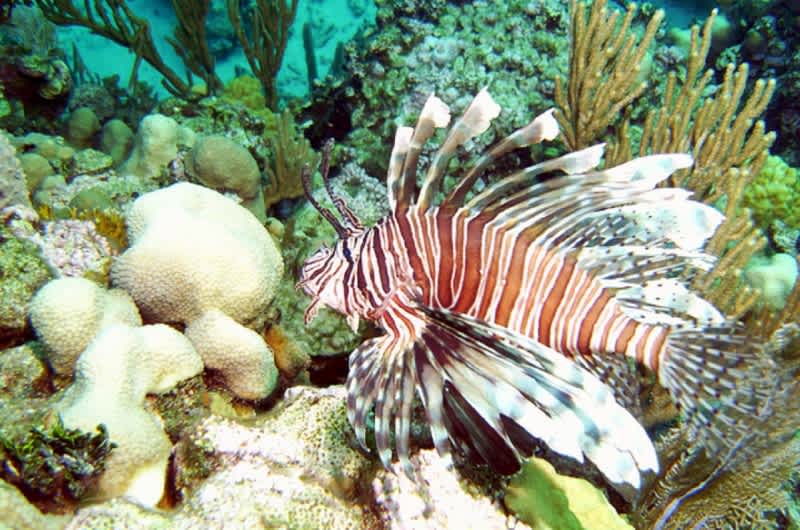What You Need to Know About The Gulf Coast Lionfish Invasion
OutdoorHub Social 05.05.16

Upon visiting an aquarium, you may have seen a striped, spiny fish residing there. This fish, known overall as a lionfish, is actually one of two different species, those being the Red Lionfish and Devil Firefish. Due to being interesting to look at, these fish have become a popular attraction in both home and public aquariums. Where it is not so great to find one, however, is in areas such as the Atlantic Ocean or Gulf of Mexico.
Although the lionfish hails from warm waters in the west Pacific, Indian Ocean, and Red Sea, they have been able to set up camp in other parts of the world. Since lionfish are aesthetically pleasing, many were purchased as pets and it is thought that once the owner grew tired of their acquisition, the animal was released. It is also possible that storm surges overcoming neighborhoods and damaging homes could have allowed these fish their freedom, such as during hurricane season. Case in point lies in it has been proven lionfish located in the Atlantic Ocean all trace back to the same handful of females thanks to DNA evidence.
Upon arriving in this neck of the woods, the lionfish has been quick to get down to the business of breeding and feeding. This translates to a negative environmental impact as this invasive species eats voraciously, consuming just about anything and everything, tipping the scales as far as the ecosystem goes. Lionfish have no known predators thanks to their 18 venomous spines and their nonchalant attitude clearly indicates awareness of this fact. Additionally, they are able to reproduce prolifically with each female releasing up 2 million eggs in her lifespan. These eggs, contained in a sack, are able to move about freely at the mercy of ocean currents for 25 days, further enabling the invasion of the species.
Thanks to rapid breeding, lionfish populations have established a foothold in waters from Texas to New York with warm waters around Florida having high concentrations. If you travel further south in your fishing ventures, it is possible to run into them in Mexico and South America as well. Primarily they are found in reef settings, be they natural or artificial, such as sunken ships and oil rigs, and at depths up to 1,000 feet.
The good news when it comes to lionfish is that it is pretty rare that you will unexpectedly reel one in on a hook. However, if you wish catch some, you will need to properly outfit yourself before doing so. This means puncture resistant gloves for handling as well as a spear for fishing. Since lionfish like cracks and crevices, it isn’t always possible to scoop them up with a net, hence a spear being necessary. Even the most inexperienced spear fishermen can usually land lionfish as they are slow moving and don’t flee in your presence, even after you spear their nearby buddy as seen in this video courtesy of Alex Fogg with Florida Fish and Wildlife.
In the even that you are stung by a lionfish, the reaction can be quite severe. In some cases medical care will be required as you may experience dizziness as well as swelling at the injection site along with the development of blisters and necrosis. Temporary paralysis can occur as well. To treat stings, soaking in hot water for a half an hour on up to 90 minutes is suggested, but do not hesitate to seek medical intervention if you feel it necessary.
To preserve the ecosystem and the future of fishing and aquatic habitats as a whole, there are efforts underway to remove lionfish from areas to which they are not native. At times bounties are offered during which a set dollar amount is paid for harvested fish based on the availability of funds. Also popular are removal events in a tournament or derby setting in which a day or weekend event aims to remove as many lionfish as possible. Prizes are awarded and ideally a dent is made in the ever-growing population. If you’re interested in participating in such an event, resources for finding one include Reef Rangers or the Gulf Coast Lionfish Coalition.
Once you’ve bagged a lionfish, then what? Well, by many accounts they make for a good meal, being said to have a taste similar to snapper or grouper. Just be sure to exercise caution when handling lionfish, again utilizing protective gloves. Otherwise take care to avoid the dorsal, anal, and pelvic fins and filet as you would any other fish. The end result will be a nice piece of boneless, white meat that you can prepare however you wish.
Speaking of feasting on lionfish, this is something we should embrace whether or not we make the choice to fish for them. By asking for lionfish in restaurants, we can create a demand. Once a demand occurs, a supply will follow, creating a market for lionfish and enabling a need for commercial fishing. As these pieces of the puzzle fall into place, it becomes attractive to commercial divers and fishermen to seek out lionfish from a financial standpoint, which at the same time helps to save our oceans from the voracious appetite of the lionfish.
Lionfish may have shown up uninvited, but that doesn’t mean we have to stand idly by and watch their reign of destruction. Instead, we can suit up and take a stand with spear in hand, or at least turn the tables and make a meal out of the predatory lionfish before they devour our oceans and kill our reefs.

